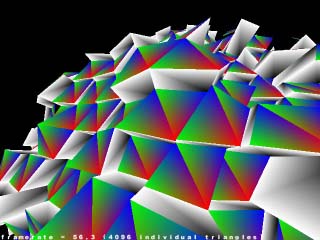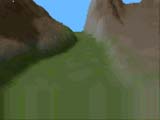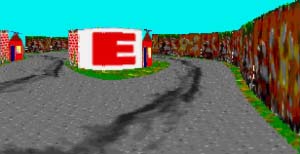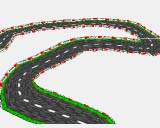| Hacks of existing engines: |
|
| Fisheye Quake |
|
Fisheye projection version of the quake engine (software rendering),
here.
|
| PanQuake |
|
Panoramic projection version of the quake engine (OpenGL rendering),
here.
|
|
Own engines (in reverse chronological order) |
|
| Sauerbraten (2002) |
|
Experimental engine taking the concepts of Cube to the extreme. Page
here.
|
| Cube (2001) |
|
LOD-Landscape-style engine that pretends to be an indoor first person shooter engine, with
in-game map editing (even cooperative), client server network code, physics, and gameplay.
Cube has its own page here.
|
| Sphere (2000) |
|
Landscape engine whose surface is a sphere. Maps the world to one big triangle which
is rendered spherically using subdivision and normalisation. Allows for both "walls" and
heightfields in its map format.
|
| Splat (1998) |
|
An experimental portal test engine which does fisheye projection rendering (which doesn't deal with
T-joints and thus relies on high subdivision of surfaces), and has provisions
for in-engine geometry editing (the engine uses an auto-portalisation scheme).
The engine was designed for software rendering and is highly portable (runs on Amiga / Unix X11 / Linux SVGA / Windows DirectX), but has also been ported to OpenGL.
|
| Voxel (1997) |
|
Simple voxel engine, running on Amiga & X11.
|
| Mario (1997) |
|
Software rendering ray casting engine (highly optimised 68k machine code), indended for
use in a racing game. Beautiful because of its simplicity: in only 5k of mixed assembly &
E source code, it managed to render a floor and walls, using a single 256 colour image
file for the definition of the floor, wall positions and textures placed upon them (it
uses specific pixel values to mean "render a wall here with this texture on it"). Could
do a variety of scenery, nice round tracks, and had variable fov (panoramic rendering, see third shot),
viewpoint height, pitch & fake roll (for simulating G-forces).
|
| Tmap (1997) |
|
Software rendering 6-DOF polygon engine (highly optimised 68k machine code), indended for
use in a racing game. Never got beyond rendering track + scenery because it ran
too slow on my 40mhz Amiga.
Go back to my main page.
|








